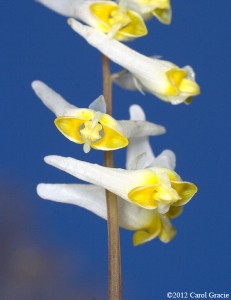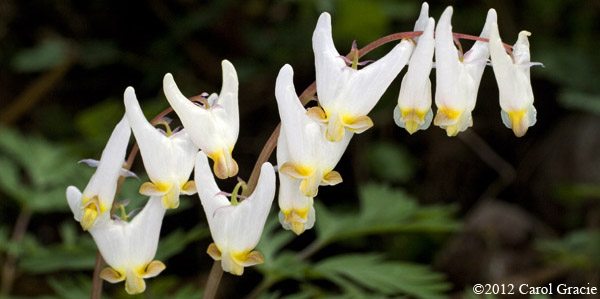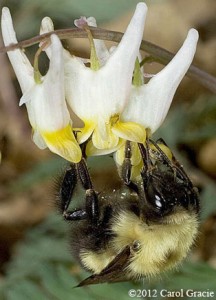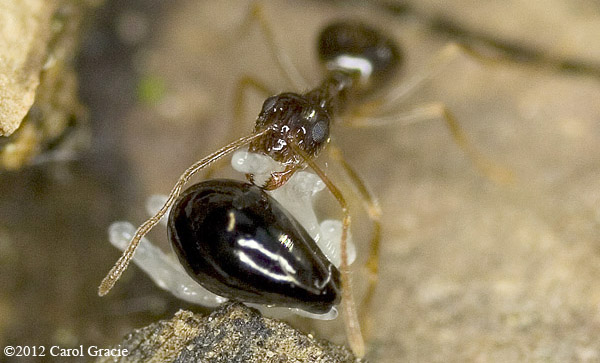Dutchman’s Breeches: Pantaloons Fit for a Queen
Posted in Science on April 12 2013, by Carol Gracie
After spending nearly three decades at the NYBG, and working much of that time in South American rainforests with her husband, Scott A. Mori, Carol Gracie has returned to one of her first botanical interests in retirement–local wildflowers. She is the author of Spring Wildflowers of the Northeast: A Natural History and coauthor (with Steve Clemants) of Wildflowers in the Field and Forest: A Field Guide to the Northeastern United States.

In the early spring wildflower parade, Dutchman’s breeches (Dicentra cucullaria) follow closely on the heels of hepatica, blooming by mid-April. Dutchman’s breeches are one of the true spring ephemerals, plants that complete their entire above-ground life cycle within a period of only a few weeks and then disappear until the following spring. Of course, the underground portions live on, storing the carbohydrates manufactured by the leaves during the brief period before the trees have leafed out and shaded the forest floor. But spring ephemerals are not roadside plants.
To see most of our native ephemerals requires a pleasant walk in the woods. Ephemerals are plants that have evolved to live in the primeval conditions of Eastern North America—a land once covered by forest. They must take advantage of the short period of year when temperatures are warm enough and sunlight sufficient enough on the forest floor for the plant to accomplish three tasks: food production, reproduction, and storage of carbohydrates for the subsequent year’s growth.

The origin of the common name of Dutchman’s breeches is obvious when the plant is in flower. The inflorescence looks like a pink clothesline hung with several pairs of white pantaloons, the type worn in Holland many years ago. The unique structure of the flowers leads one to wonder what pollinates them. With nectar stored at the very tip of the elongated spur petals (the pantaloons), the insect must have a long proboscis in order to reach it, and it must be able to fly in the cool temperatures of April. Bumblebees, with their fuzzy coats, are well suited for flying at cool temperatures, and they are attracted to flowers with contrasting colors or patterns.

In early spring, queen bumblebees (Bombus spp.), are active—busily seeking both pollen and nectar to begin new colonies. Only queen bees survive the winter; all others of her species die off over the course of the previous autumn. The queen, who was fertilized in the previous year, spends the winter in a sheltered spot, and in spring must find a suitable place to begin a nest; nectar to satisfy her energy requirements; and pollen to provision the nest for the next generation. Once all of this has been accomplished, the queen begins to lay eggs. The two species, flower and bee, have co-evolved to satisfy each other’s needs—an early source of food for the bee and pollination for the flower.
Dutchman’s breeches has an interesting method of seed dispersal as well, one shared by many other spring ephemerals. When the tiny (2 mm) seeds fall to the ground, they are rapidly removed by ants. The seeds are hard and shiny, but attached to each is a fleshy white appendage, called an elaiosome, that the ants can grasp in their mandibles.
It is this oil-filled, nutrient-rich body that the ants are attracted to. They carry the seeds back to their nest where they consume the elaiosome and cast out the seed in their refuse piles. Thus, the seeds are dispersed at some distance from the parent plant into an area that might be suitable for growth—an advantage should anything destroy the original population. Some other spring ephemerals that utilize this same dispersal system are bloodroot, trillium, violets, and spring beauty. Violets and spring beauties first fling their seeds from the capsules by the ballistics of the explosive seedpod.

Read about nectar robbers and other curious facts of Dutchman’s breeches life in my book, Spring Wildflowers of the Northeast: A Natural History, available at Shop in the Garden. Dutchman’s breeches may be seen in the new Native Plant Garden during the Grand Opening Weekend, May 3–5, 2013.

